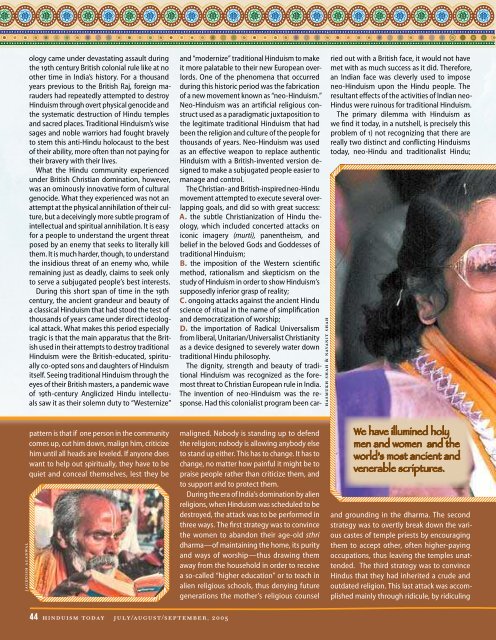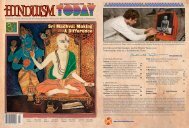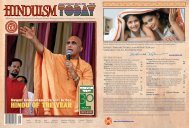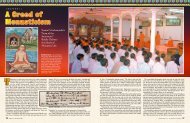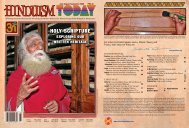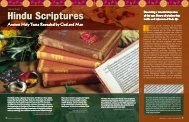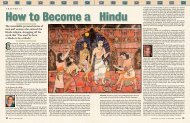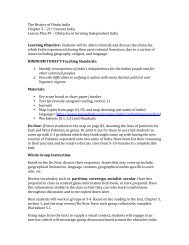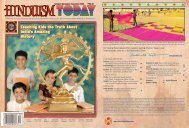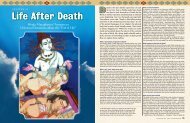Hinduism Today July/August/September 2005
Hinduism Today July/August/September 2005
Hinduism Today July/August/September 2005
You also want an ePaper? Increase the reach of your titles
YUMPU automatically turns print PDFs into web optimized ePapers that Google loves.
ology came under devastating assault during<br />
the 19th century British colonial rule like at no<br />
other time in India’s history. For a thousand<br />
years previous to the British Raj, foreign marauders<br />
had repeatedly attempted to destroy<br />
<strong>Hinduism</strong> through overt physical genocide and<br />
the systematic destruction of Hindu temples<br />
and sacred places. Traditional <strong>Hinduism</strong>’s wise<br />
sages and noble warriors had fought bravely<br />
to stem this anti-Hindu holocaust to the best<br />
of their ability, more often than not paying for<br />
their bravery with their lives.<br />
What the Hindu community experienced<br />
under British Christian domination, however,<br />
was an ominously innovative form of cultural<br />
genocide. What they experienced was not an<br />
attempt at the physical annihilation of their culture,<br />
but a deceivingly more subtle program of<br />
intellectual and spiritual annihilation. It is easy<br />
for a people to understand the urgent threat<br />
posed by an enemy that seeks to literally kill<br />
them. It is much harder, though, to understand<br />
the insidious threat of an enemy who, while<br />
remaining just as deadly, claims to seek only<br />
to serve a subjugated people’s best interests.<br />
During this short span of time in the 19th<br />
century, the ancient grandeur and beauty of<br />
a classical <strong>Hinduism</strong> that had stood the test of<br />
thousands of years came under direct ideological<br />
attack. What makes this period especially<br />
tragic is that the main apparatus that the British<br />
used in their attempts to destroy traditional<br />
<strong>Hinduism</strong> were the British-educated, spiritually<br />
co-opted sons and daughters of <strong>Hinduism</strong><br />
itself. Seeing traditional <strong>Hinduism</strong> through the<br />
eyes of their British masters, a pandemic wave<br />
of 19th-century Anglicized Hindu intellectuals<br />
saw it as their solemn duty to “Westernize”<br />
hasmukh shah & navanit shah<br />
and “modernize” traditional <strong>Hinduism</strong> to make<br />
it more palatable to their new European overlords.<br />
One of the phenomena that occurred<br />
during this historic period was the fabrication<br />
of a new movement known as “neo-<strong>Hinduism</strong>.”<br />
Neo-<strong>Hinduism</strong> was an artificial religious construct<br />
used as a paradigmatic juxtaposition to<br />
the legitimate traditional <strong>Hinduism</strong> that had<br />
been the religion and culture of the people for<br />
thousands of years. Neo-<strong>Hinduism</strong> was used<br />
as an effective weapon to replace authentic<br />
<strong>Hinduism</strong> with a British-invented version designed<br />
to make a subjugated people easier to<br />
manage and control.<br />
The Christian- and British-inspired neo-Hindu<br />
movement attempted to execute several overlapping<br />
goals, and did so with great success:<br />
A. the subtle Christianization of Hindu theology,<br />
which included concerted attacks on<br />
iconic imagery (murti), panentheism, and<br />
belief in the beloved Gods and Goddesses of<br />
traditional <strong>Hinduism</strong>;<br />
B. the imposition of the Western scientific<br />
method, rationalism and skepticism on the<br />
study of <strong>Hinduism</strong> in order to show <strong>Hinduism</strong>’s<br />
supposedly inferior grasp of reality;<br />
C. ongoing attacks against the ancient Hindu<br />
science of ritual in the name of simplification<br />
and democratization of worship;<br />
D. the importation of Radical Universalism<br />
from liberal, Unitarian/Universalist Christianity<br />
as a device designed to severely water down<br />
traditional Hindu philosophy.<br />
The dignity, strength and beauty of traditional<br />
<strong>Hinduism</strong> was recognized as the foremost<br />
threat to Christian European rule in India.<br />
The invention of neo-<strong>Hinduism</strong> was the response.<br />
Had this colonialist program been carried<br />
out with a British face, it would not have<br />
met with as much success as it did. Therefore,<br />
an Indian face was cleverly used to impose<br />
neo-<strong>Hinduism</strong> upon the Hindu people. The<br />
resultant effects of the activities of Indian neo-<br />
Hindus were ruinous for traditional <strong>Hinduism</strong>.<br />
The primary dilemma with <strong>Hinduism</strong> as<br />
we find it today, in a nutshell, is precisely this<br />
problem of 1) not recognizing that there are<br />
really two distinct and conflicting <strong>Hinduism</strong>s<br />
today, neo-Hindu and traditionalist Hindu;<br />
and 2) traditionalists being the guardians of<br />
authentic Dharma philosophically and attitudinally,<br />
but not yet coming to full grips with<br />
the modern world—i.e., not yet having found<br />
a way of negotiating authentic Hindu Dharma<br />
with modernity in order to communicate the<br />
unadulterated Hindu Dharma in a way that the<br />
modern mind can fully appreciate it. <strong>Hinduism</strong><br />
will continue to be a religion mired in confusion<br />
about its own true meaning and value<br />
until traditionalist Hindus can assertively, professionally<br />
and intelligently communicate the<br />
reality of genuine <strong>Hinduism</strong> to the world. Until<br />
they learn how to do this, neo-<strong>Hinduism</strong> will<br />
continue its destructive campaign.<br />
The Non-Hindu Origins of<br />
Radical Universalism<br />
Radical Universalism is neither traditional nor<br />
classical. Its origins can be traced back to the<br />
early 19th century. It is an idea not older than<br />
two centuries. Its intellectual roots are<br />
not even to be found in <strong>Hinduism</strong> itself,<br />
but rather are clearly traced back<br />
to Christian missionary attempts to alter<br />
the genuine teachings of authentic<br />
<strong>Hinduism</strong>. Radical Universalism was<br />
in vogue among 19th century Britisheducated<br />
Indians, most of who had<br />
little accurate information about their<br />
own Hindu intellectual and spiritual heritage.<br />
These Westernized Indians were often overly<br />
eager to gain acceptance and respectability<br />
for Indian culture from a Christian European<br />
audience who saw in <strong>Hinduism</strong> nothing more<br />
than the childish prattle of a brutish, colonized<br />
people. Many exaggerated stereotypes about<br />
<strong>Hinduism</strong> had been unsettling impressionable<br />
European minds for a century previous to their<br />
era. Rather than attempting to refute these<br />
many stereotypes about <strong>Hinduism</strong> by presenting<br />
<strong>Hinduism</strong> in its authentic and pristine form,<br />
however, many of these 19th-century Christianized<br />
Indians felt it was necessary to instead<br />
gut <strong>Hinduism</strong> of anything that might seem offensively<br />
exotic to the European mind. Radical<br />
Universalism seemed to be the perfect base<br />
notion upon which to artificially construct a<br />
“new” <strong>Hinduism</strong> that would give the Anglicized<br />
The main apparatus that the British<br />
used in their attempts to destroy<br />
traditional <strong>Hinduism</strong> were the British<br />
educated, spiritually co-opted sons<br />
and daughters of <strong>Hinduism</strong> itself.<br />
19th-century Indian intelligentsia the acceptability<br />
they so yearned to be granted by their<br />
British masters.<br />
We encounter one of the first instances of<br />
the Radical Universalist infiltration of <strong>Hinduism</strong><br />
in the syncretistic teachings of Ram Mohan<br />
Roy (1772-1833), the founder of the Brahmo<br />
Samaj. A highly controversial figure during his<br />
life, Roy was a Bengali intellectual who was<br />
heavily influenced by the teachings of the Unitarian<br />
Church, a heterodox denomination of<br />
Christianity. In addition to studying Christianity,<br />
Islam and Sanskrit, he studied Hebrew and<br />
Greek with the dream of translating the Bible<br />
into Bengali. A self-described Hindu “reformer,”<br />
he viewed <strong>Hinduism</strong> through a colonial Christian<br />
lens. The Christian missionaries had told<br />
Roy that traditional <strong>Hinduism</strong> was a barbaric<br />
religion that had led to oppression, superstition<br />
and ignorance of the Indian people. He<br />
believed them. More, Roy saw Biblical teachings,<br />
specifically, as holding the cherished<br />
key to altering traditional Hindu teachings to<br />
make them more acceptable to India’s colonial<br />
masters. In his missionary zeal to Christianize<br />
<strong>Hinduism</strong>, he even wrote an anti-Hindu tract<br />
known as The Precepts of Jesus: The Guide to<br />
Peace and Happiness. It was directly from these<br />
Christian missionaries that Roy derived the<br />
jagddish agarwal<br />
pattern is that if one person in the community<br />
comes up, cut him down, malign him, criticize<br />
him until all heads are leveled. If anyone does<br />
want to help out spiritually, they have to be<br />
quiet and conceal themselves, lest they be<br />
maligned. Nobody is standing up to defend<br />
the religion; nobody is allowing anybody else<br />
to stand up either. This has to change. It has to<br />
change, no matter how painful it might be to<br />
praise people rather than criticize them, and<br />
to support and to protect them.<br />
During the era of India’s domination by alien<br />
religions, when <strong>Hinduism</strong> was scheduled to be<br />
destroyed, the attack was to be performed in<br />
three ways. The first strategy was to convince<br />
the women to abandon their age-old sthri<br />
dharma—of maintaining the home, its purity<br />
and ways of worship—thus drawing them<br />
away from the household in order to receive<br />
a so-called “higher education” or to teach in<br />
alien religious schools, thus denying future<br />
generations the mother’s religious counsel<br />
We have illumined holy<br />
men and women and the<br />
world’s most ancient and<br />
venerable scriptures.<br />
and grounding in the dharma. The second<br />
strategy was to overtly break down the various<br />
castes of temple priests by encouraging<br />
them to accept other, often higher-paying<br />
occupations, thus leaving the temples unattended.<br />
The third strategy was to convince<br />
Hindus that they had inherited a crude and<br />
outdated religion. This last attack was accomplished<br />
mainly through ridicule, by ridiculing<br />
every aspect of the religion that could possibly<br />
be ridiculed.<br />
Though India was politically dominated for<br />
generations by adherents of alien faiths, and<br />
though every attempt was made to discourage,<br />
weaken and crush the native religion, the<br />
carefully calculated, systematic assault failed<br />
to destroy <strong>Hinduism</strong>. <strong>Hinduism</strong> cannot be<br />
destroyed. It is the venerable eternal religion,<br />
the Sanatana Dharma. But it was an effective<br />
campaign that has left in its wake deep samskaric<br />
patterns, deep subconscious impressions,<br />
which still persist in the minds of the Indian<br />
people. It is going to be difficult to completely<br />
eradicate these impressions, but with the help<br />
of all the millions of Hindus throughout the<br />
world, in adhering to and extolling the benefits<br />
and joys of <strong>Hinduism</strong> and the gifts which it<br />
holds for mankind, this is possible and feasible,<br />
within the range of accomplishment, perhaps<br />
within this very generation.<br />
There are Hindus in every country of the<br />
world today, but they are struggling to adjust<br />
to life in other societies, not sure of what to<br />
accept for the benefit of themselves and their<br />
families and what to reject. Many are ashamed,<br />
having accepted the samskaras of ridicule<br />
aimed at their religion by the missionaries of<br />
other religions and therefore cower behind<br />
the doctrines of alien religions or no religion<br />
at all, apart from an existential fear of the annihilation<br />
of consciousness at death. The Hindu<br />
framework of thinking, of emotional management<br />
and of knowledge does not allow for the<br />
existence of a Western influence. But there are<br />
Hindus in the frustrated Western world, and<br />
this is a reality. To them I say, Courage! Courage!<br />
Courage! Have the courage to come forth<br />
with your religion. Don’t be a victim of the calculated<br />
ridicule aimed at the destruction of<br />
your religion, which is the destruction of your<br />
religion and of you and future generations if<br />
you accept it. <strong>Hinduism</strong> is one of the great reli-<br />
44 hinduism today j uly/august/sep t ember , 2 0 05 j u ly/august/sep t ember , 2 0 05 h i n d u i s m t o d ay 45


